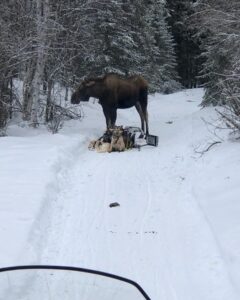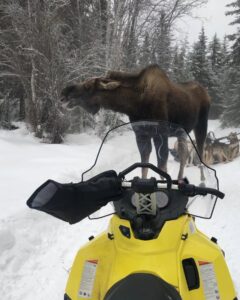
By Dave Workman
Editor-in-Chief
Her injured sled dogs are healing, her spirits are high and for Alaska’s Bridgett Watkins, the musher who made national news this week because of a wild confrontation with a bull moose—the kind of incident from which legends are sometimes born—the experience seems only to have reinforced her plans to run in the fabled Iditarod—called “the last great race” by its fans—early next month.
Speaking by phone with TheGunMag.com, the 38-year-old mother of two and a registered emergency room nurse at a Fairbanks hospital, Watkins seems to accept her new celebrity status in stride. She’s more focused on her injured dogs and the upcoming race in which she definitely intends to compete.
“I’ve still got 12 dogs that want to run,” she said with a cheerful voice. “They just want to go, and I can’t rightfully not run.”
She has “faced here fears” since the encounter a week ago, and has been back on the sled continuing preparations for the big 1,000-mile race for the past three years. As part of the process, she has participated in qualifying races out to 300 miles.
“I had to prove I could compete,” she explained.
Bridgett and her husband, Scotty and their sons live southeast of Fairbanks and call their home “Kennel On A Hill.” It’s not a commercial operation, but what could easily be called a labor of love. Born in Arkansas but transplanted as a child with her parents more than 30 years ago, Bridgett told TGM she’s been mushing for three decades.
But nothing quite like the recent moose encounter has happened to her before. On a training run along the Salcha River trail, accompanied by a friend who was riding behind her on a snowmobile with several other dogs, they crossed paths with the huge bull, which had shed its antlers but was no less a formidable obstacle.
In a narrative to Outdoor Life published online, Watkins first spotted the animal from several hundred yards away. She and her friend stopped to give the moose time to move on. The moose had different plans. What followed went on for about an hour.
Armed with only a .380 ACP pocket pistol, which she had along at the time for personal protection, Watkins did not want any trouble with the critter. However, the moose essentially called the play and gradually came closer, moving in and out of the brush. When he got to within about 150 yards, Watkins concluded this was not going to go well. She pulled out the pistol, which quickly showed the limitations of a small caliber bullet against a very big target.
“On this particular day,” she told TGM, “I went into a gunfight with a slingshot.”
“I was carrying a .380 because in the mushing world,” she explained, “we’re not going out to hunt or kill any animal. I am a hunter myself. I take animals for meat.”
There are several images on her Facebook page depicting outdoor excursions, hunting and fishing.
But on a race, “this is not the time or the place for that to occur,” she said.
The moose was aggressive from the get-go as he came closer. When he moved in, she fired at fairly close range, firing at the chest and back. The small-caliber pistol had no deterrent effect at all, and the moose continued its charge, threatening both Bridgett and her friend.
“He never stopped,” she recalled. “He came full blast right at me. I took a deep breath because I wanted to make an accurate shot.”
She aimed for the animal’s chest but hit it in the jaw because he lowered his head during the charge. The next shot was in the hump area between the animal’s shoulders.
But the huge animal turned his attention to Bridgett’s dog team. With her dogs injured and small pistol empty, Watkins called a friend who arrived with a rifle and killed the crazed animal.
Ultimately, four dogs in her team were seriously injured, and she said they are being nursed back to health at home, staying in the house, and it will take some time for them to recover. Other dogs in the team suffered minor “cuts, scrapes and bruises,” and are mostly healed, and obviously eager to hit the trail anew.

Bridgett said there has been a lot of snow this winter and it has been tough on local wildlife, which may explain why the moose was using the sled trail. It doesn’t fully explain the animal’s surly disposition, although Watkins indicated it had suffered some leg injuries apparently from moving through the deep snow.
Because the little .380 ACP rounds didn’t seem to discourage the moose, Bridgett acknowledged she is now carrying a .44 Magnum revolver, which has a lot more energy and stopping power. The big double-action wheelgun is carried in a chest holster.
She noted that it is not uncommon for mushers to not have a firearm at all. Many will have an axe or flare gun, the latter which will often be used scare off an aggressive animal. But not this time.
A hunter with “all kinds of guns,” Bridgett liked having the .380 along because it slips into the pocket of her parka. After the moose encounter, she gave that a serious re-think.
In an update on her Facebook page, Bridgett says the dogs—Flash, Bronze, Bill and Jefe—are in various stages of healing.
“This has been exhausting,” she writes, “literally taking hours each day-but worth every minute to see improvements. My nearly 20 years of nursing in the ER has paid off to say the least. God gives us the tools we need to do the job in front of us. You all made it possible and I will forever be eternally grateful for the love, prayers and support showered upon us…”
Several lines later, Bridgett adds, “These dogs are amazing! It has taken an army to get us here. We are warriors are will not give up. Keep praying for us-Iditarod is just 3 weeks away.”
While she does not expect to win, Bridgett is in this race for the long haul, and she intends to cross the finish line.
“For us and my team,” she said, “we’re not going to be running to win but to compete. We’ll run 50 miles and rest, and then run again…I’m going for it. This isn’t the end of my story, it’s like the beginning. We all do super hard stuff in our lives. I’m going for it.”



